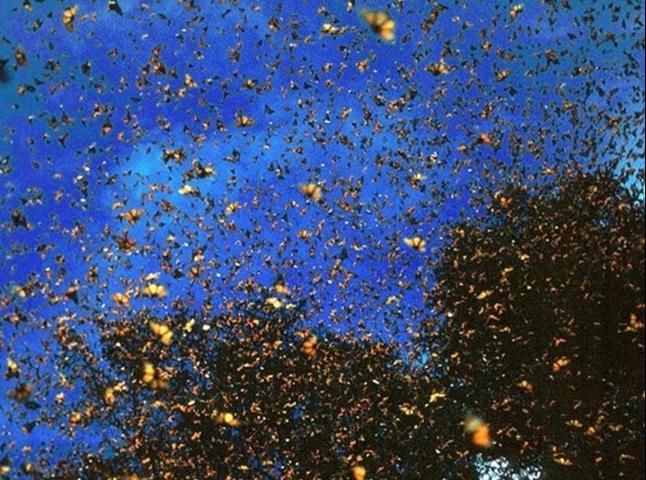
A Natural Wonder in Jeopardy
The monarch (Danaus plexippus) is one of the most abundant and widely recognized butterflies in the world. Like most butterflies, monarchs are pollinators that play an important ecological role in maintaining biological diversity. But this species also displays a pattern of behavior that is unique among all insects. Anyone who has observed the tens of millions of monarchs filling the sky along their migration route, or a blanket of iridescent orange covering entire trees on the wintering grounds, has an indelible mark upon their memories. Even though the monarch is not threatened as a species, its migration—one of the world's great natural wonders—is considered an "endangered natural phenomenon."
While other butterflies, including others in the Danainae family (the "milkweed butterflies"), migrate, the monarch is the only butterfly species in the world to undertake a long-distance roundtrip migration. Each fall, monarchs west of the Rocky Mountains travel to specific sites on the California coast, while monarchs from the eastern U.S. and southern Canada undertake a much longer journey, up to 3,000 miles, to wintering grounds in the mountains of central Mexico (Figure 2). The scope of this migration resembles that of many bird species, and the fact that it is being undertaken by a paper-thin insect weighing less than one gram is truly a source of wonder. Researchers are still uncertain how monarchs navigate their journey, but believe that they use a combination of directional aids such as the magnetic pull of the earth and the position of the sun, rather than a single method. More amazing still, the butterflies that migrate each fall are three or more generations removed from those that made the journey the previous year. Thus the monarch's migration differs from those of vertebrate species, in which the annual migration is completed by some of the same individuals that completed it the previous year, and their offspring. Birds and mammals learn migratory routes from their parents, but monarchs don't live long enough to "teach" their children how to migrate! The migratory generation originates in the fall with adults living for eight or nine months, just long enough to travel to Mexico or California, endure the winter, and return to the southern U.S. to lay eggs before dying. Over the summer, three or four generations of monarchs are produced. These summer generations have a much shorter lifespan than the migratory generation—only three to five weeks because they devote much of their resources to reproduction. By the end of the summer, the third or fourth generations make their way back to the place their grandparents or great grandparents came from the previous spring.
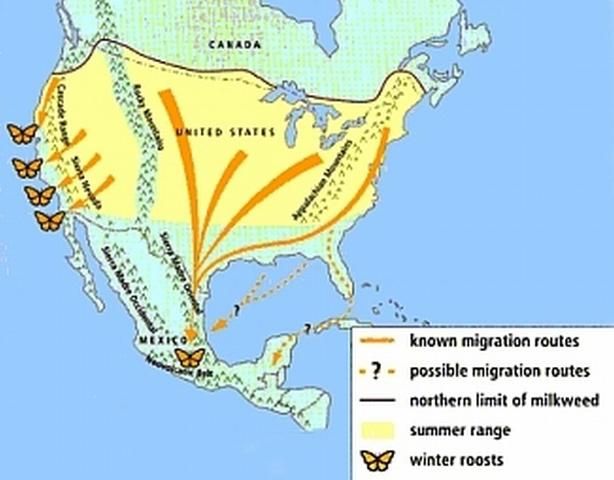
In addition to repopulating the continent, the long-distance migration serves to keep the monarch population genetically healthy and relatively disease-free. However, the migration is now threatened by environmental factors such as global warming, habitat loss at the wintering sites, the loss of milkweed plants along the migration route, and an increase in naturalized tropical milkweeds in mild climates. The result could be the replacement of large migratory populations with smaller, less healthy remnant populations that stay in one location and breed year-round.
Florida Monarchs
Because of the warm climate and continuous availability of host plants, much of Florida's monarch population stays in the state year-round and breeds continuously throughout the year. Year-round residents are more common in southern Florida, as cold winter temperatures in northern Florida can kill monarchs at any life stage. In addition to resident populations, the state also hosts migratory monarchs from northeastern North America, but there are competing hypotheses regarding how these migrants travel to, from, or through Florida.
According to Dr. Karen Oberhauser, Florida is a terminal destination for migrating monarchs from the northeastern United States and southeastern Canada. She posits that these monarchs fly into Florida but don't disperse out, making the Florida population a "sink population." In southern Florida in particular, the warm climate likely stimulates monarchs' reproductive behavior, which upsets hormonal balance and causes them to lose their ability to migrate north. Thus monarchs that migrate to southern Florida may stay and become part of the local breeding populations. Recent research by Cristina Dockx and colleagues, however, suggests that some migrants start to return north each spring, and after several successive generations they eventually reach their natal grounds in northeastern North America.
It is also possible that Florida is a stopover for migrating monarchs on their way to the Mexican wintering grounds (Figure 2). Migration from Florida to Mexico remains largely hypothetical, but researcher Gary Noel Ross has observed thousands of monarchs on oil platforms in the central Gulf of Mexico, indicating that they cross from Louisiana to northeastern Mexico each fall. However, a recent study by Elizabeth Howard and Andrew Davis found that monarch roosts along the East Coast flyway lagged behind roosts in the central U.S. flyway, suggesting that monarchs migrating down the East Coast are less likely to make it to the Mexico wintering site. Christina Dockx and colleagues contend that monarchs found in St. Marks National Wildlife Refuge (Florida panhandle) are heading to Mexico, whereas those found in southern Florida spend their winters either in southern Florida, Cuba, or other areas of the Caribbean.
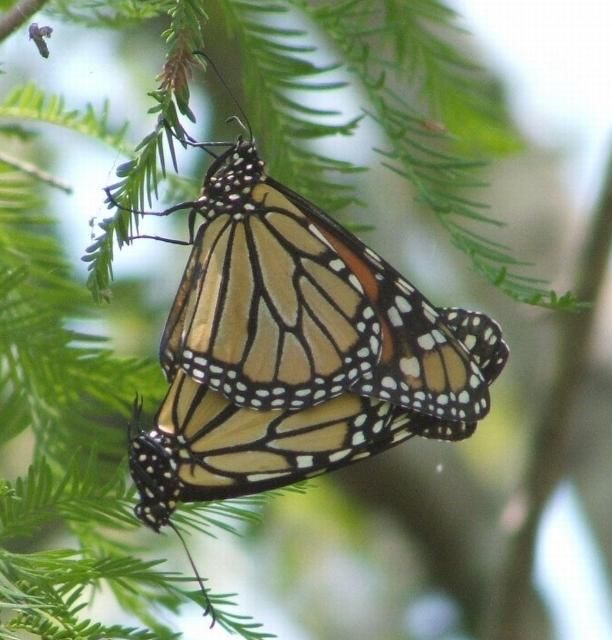
Loss of Milkweeds = Loss of Monarchs
A butterfly's range depends more on the availability of host plants for larvae than on nectar plants for adults, so protecting larval hosts is a higher priority for butterfly conservation than is protecting the nectar plants that appear in many butterfly gardens. The monarch's larval host plant is the milkweed (genus Asclepias), of which there are more than 100 species across North America.
Milkweeds grow most abundantly in disturbed habitats such as agricultural landscapes and along roadsides, but they are in decline for several reasons. Urban and suburban development is eliminating monarch habitat by supplanting agricultural landscapes where an estimated 90% of milkweeds occur. The increasing use of herbicides in agriculture is also leading to milkweed loss. The widespread use of genetically modified crops, such as herbicide-resistant corn and soybeans, exacerbates the problem because it enables growers to indiscriminately spray their fields with herbicides rather than tilling to control weeds. The organization Monarch Watch estimates that the adoption of genetically modified crops has led to the loss of more than 80 million acres of monarch habitat. Along roadsides, the ubiquitous use of herbicides and frequent mowing are also killing milkweeds and hence eliminating vital monarch habitat.
There may not be enough milkweed habitats left to sustain monarch populations at earlier levels. While year-to-year counts of monarchs vary widely, the World Wildlife Fund-Mexico has detected a downward trend in size of the Mexico winter colonies since the mid-1990s. In addition to loss of milkweeds throughout North America, illegal logging of forests on the Mexican wintering grounds is a major threat to the population.
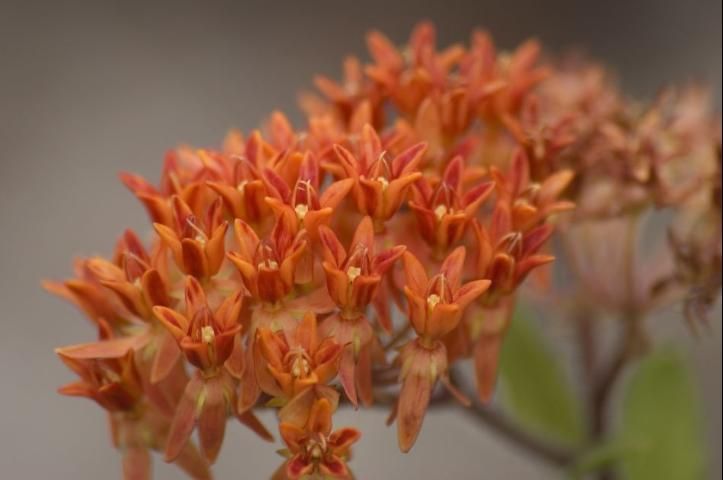
Creating Monarch Habitat in South Florida
One apparently obvious solution to the loss of monarch habitat is to plant more milkweeds. Indeed, we can protect our monarch population by compensating for the loss of habitat, but how we create these habitats is important. Butterflies depend on particular microhabitats—small areas within an ecosystem that have specific conditions and resources, such as vegetational structure, microclimate, moisture, and presence/absence of other animals (predators or competitors). Such close attention to particulars is especially important when creating habitat for non-migratory butterflies (like many monarchs in south Florida), which tend to spend their lives in a very small area and thus have more specific habitat requirements than migrants.
To develop appropriate habitats for monarchs, we need to move beyond thinking only about particular host species toward a focus on planting native communities. Backyard butterfly garden programs usually do not encourage gardeners to consider nearby plant communities (forests, prairies, or parks) when choosing plants for their gardens. Such programs often promote homogenous plantings and tend to focus on species that have beautiful flowers, attract butterflies, bloom year-round, and require little attention. This often means that they promote nonnative, potentially invasive plant species. In fact, one of the most frequently recommended plants for monarch gardens is an exotic species, scarlet milkweed (Asclepias curassavica, also known as tropical milkweed or bloodflower).
There are 21 native milkweed species in Florida and eight native species in south Florida (see sidebar). While some of these species may not be quite as showy as A. curassavica, they work perfectly well as monarch attractants. Gardeners should rest assured that monarchs are well adapted to consuming these native species. For example, while butterflyweed (A. tuberosa) has tougher leaves than scarlet milkweed (and in fact monarchs need to eat more of this plant than other species to get the nutrients they need), caterpillars that eat only A. tuberosa grow just as well as those that eat other species including A. curassavica.
In addition to milkweeds, a monarch garden needs nectar plants to provide food for adult monarchs. See sidebar for a list of nectar plants that are native to south Florida.
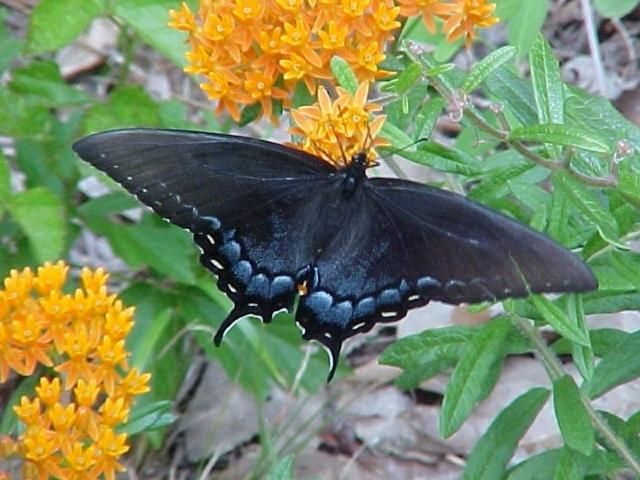
The Threat of Nonnative Milkweeds
Scarlet milkweed is native to South America but has become a naturalized weed in tropical and subtropical areas throughout the world. Whereas most other milkweeds do not grow aggressively, scarlet milkweed has been found to be self-compatible (individual plants can seed themselves) which enables it to spread more effectively. This species establishes itself most readily in dry, sandy, disturbed areas, but also grows in mucky soils in swamps (such as Coconut Creek Maple Swamp in Broward County, Florida—see Figure 6). It has become invasive—meaning it aggressively takes over habitat of native species—on many Pacific Islands (e.g., Galápagos, Fiji, Society Islands, Hawaii) and in some Pacific Rim countries (e.g., Australia, China, Malaysia). In the continental U.S. it is established in Florida, Georgia, South Carolina, Tennessee, Louisiana, Texas, and some coastal areas of southern California.
All milkweeds contain toxins, called cardenolides, which the monarch has adapted to be able to ingest. These toxins serve to protect both the plants and the monarchs from predators. Scarlet milkweed contains much higher amounts of toxins than native milkweeds. Monarchs do not discriminate between Asclepias that have high or low toxicity; higher toxicity milkweed may hinder larval performance, but it may also provide additional protection from predation. More research into scarlet milkweed's effects is needed because it may have adverse effects on monarchs that we do not yet understand.
One clear harmful effect the increase in tropical milkweeds in mild climates has had on monarchs is the resulting establishment of year-round monarch populations in new locations, such as Bermuda and Texas. This development might seem beneficial, but research at Emory University demonstrated that migrating monarchs have a much lower occurrence of parasites than those that do not migrate. Therefore, any new resident populations resulting from an increase in tropical milkweeds are likely to be heavily infected with parasites.
In southern Florida, scarlet milkweed can be found growing wild in Palm Beach, Broward, Miami-Dade, Monroe, Lee and Hendry Counties, and in the Florida Keys. Although scarlet milkweed is not on the Florida Exotic Pest Plant Council's (FLEPPC) list of invasive species, populations are increasing throughout the state due to heavy planting and seeds being transported by the wind. The species was collected as early as 1936 in Florida, and by the 1960s it was found along roadsides, then in pastures and weedy lots, and had spread into natural areas by the 1990s. Scarlet milkweed has been observed in numerous southern Florida natural areas including Coconut Creek Maple Swamp, Bill Baggs Cape Florida State Park, Big Cypress National Preserve, Castellow Hammock, Dupuis Reserve, Corkscrew Regional Ecosystem Watershed, J.W. Corbett Wildlife Management Area, Everglades National Park, and Fisheating Creek Wildlife Management Area.
Several plant species that were recommended for butterflies in the 1980s and 1990s have become invasive and have been added to the FLEPPC list. These include, for example, blue porterweed (Stachytarpheta cayennensis), lantana (Lantana camara), Christmas cassia (Senna pendula var. glabrata), two-flowered passion vine (Passiflora biflora), and Browne's blechum (Blechum pyramidatum). With vigilance, we can learn from the past and bring scarlet milkweed under control before it becomes as invasive as these other species.
Other plants that should be avoided in the monarch garden are swallow-worts (genus Cynanchum). These plants have similar chemical properties to milkweeds and fool monarchs into laying eggs on them. However, swallow-worts are not suitable food for monarch larvae, and caterpillars fail to develop into pupae when feeding on these plants. In south Florida there are four native species of Cynanchum.
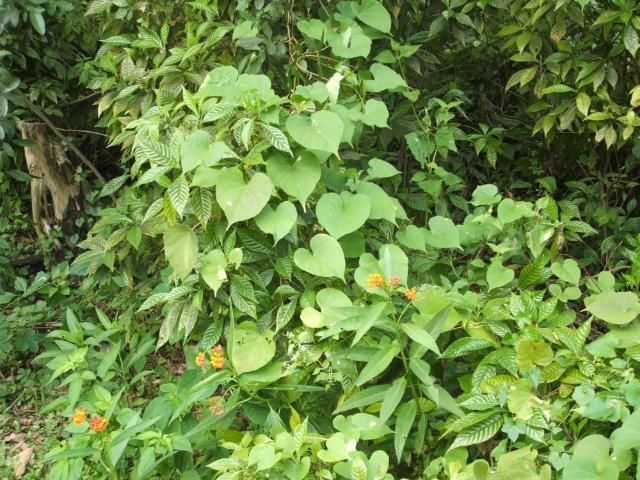
Creating Monarch Habitat along the Migration Route
Of course, the importance of planting native species for monarchs applies beyond Florida. Scarlet milkweed is not likely to establish itself in northern climes because it cannot survive a cold winter; however, it has become naturalized as far north as South Carolina and north-central California—areas that are along the major eastern and western monarch migration routes. Planting nonnative milkweeds along the migration route can increase reproductive behavior of monarchs and disrupt their migratory behavior. There are 108 native Asclepias species in North America—so wherever you live along the migration routes, there are native species you can substitute for A. curassavica in a monarch garden. For lists of Asclepias species native to each region of the U.S., visit http://plants.usda.gov/java/profile?symbol=ASCLE.
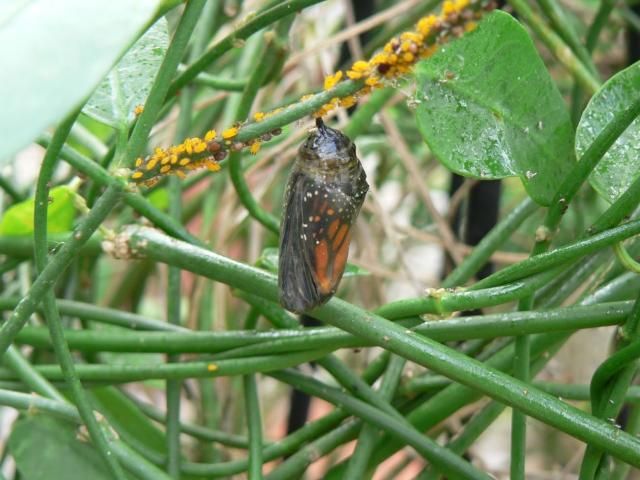
Native Larval Host Plants for Monarchs in South Florida
Curtiss' milkweed (Asclepias curtisii)
Swamp milkweed (Asclepias incarnata)
Fewflower milkweed (Asclepias lanceolata)
Longleaf milkweed (Asclepias longifolia)
Savannah milkweed (Asclepias pedicellata)
Butterflyweed (Asclepias tuberosa)
Whorled milkweed (Asclepias verticillata)
Green antelopehorn (Asclepias viridis)
White vine (Sarcostemma clausum)
Native Nectar Plants for Monarchs in South Florida
Mist flower (Conoclinium coelestinum)
Cat's tongue (Melanthera nivea)
False blazing star (Carphephorus corymbosus)
Flat-topped golden rod (Euthamia caroliniana)
Yellow top (Flaveria linearis)
Goldenrod (Solidago fistulosa, odora var. chapmanii, sempervirens or stricta)
Spanish needles (Bidens alba or bipinnata)
Blazing star (Liatris garberi, gracilis, or chapmanii)
Climbing aster (Symphyotrichum carolinianum)
Hempvine (Mikania cordifolia)
Scorpiontail (Heliotropium angiospermum
Crownbeard (Verbesina virginica)
References
Altizer, S.M., K.S. Oberhauser, and L.P. Brower. 2000. Associations between host migration and the prevalence of a protozoan parasite in natural populations of monarch butterflies. Ecological Entomology 25:125–139.
Arceneaux, A., C. Corales, E. Torok, C. Minnix, and B. Zamponi. 2001. A comparison of Opryocystic elektroschirra spore loads on Danaus plexipuus (sic) likely reared on native and non-native milkweeds. Monarch Lab Website. Updated March 2001. http://www.monarchlab.org/Lab/Research/Topics/Enemies/Projects/Westview.aspx
Brower, L.P. 1995. Understanding and misunderstanding the migration of the monarch butterfly (Nymphalidae) in North America: 1857–1995. Journal of the Lepidopterists' Society 49(4):304–385.
Cech, R. and G. Tudor. 2005. Butterflies of the East Coast: An Observer's Guide. Princeton University Press, Princeton, New Jersey.
Daniels, J. July 2009. Personal communication. University of Florida McGuire Center for Lepidoptera and Biodiversity, Florida Museum of Natural History.
Dockx, C. Unpublished manuscript. Migratory phenotypic traits differences between two groups of eastern North American monarch butterflies: Mexican vs. Florida-Cuban. University of Florida McGuire Center for Lepidoptera and Biodiversity, Florida Museum of Natural History.
Emmel, T. June 2009. Personal communication. University of Florida McGuire Center for Lepidoptera and Biodiversity, Florida Museum of Natural History.
Emory University. 2005, March 11. Emory Study Finds Monarch Health Tied To Migration. ScienceDaily. Retrieved October 9, 2009, from https://www.sciencedaily.com/releases/2005/03/050309105725.htm
Erickson, J.M. 1973. The utilization of various Asclepias species by larvae of the monarch butterfly, Danaus plexippus. Psyche, September 1973.
Goehring, L., and K.S. Oberhauser. 2004. Environmental factors influencing postdiapause reproductive development in monarch butterflies. Pages 187–198 in K.S. Oberhauser and M.J. Solensky (editors), The Monarch Butterfly: Biology and Conservation. Cornell University Press, Ithaca, New York.
Hilburn, D.J. 1989. A non-migratory, non-diapausing population of the monarch butterfly, Danas plexippus (Lepidoptera: Danaidae), in Bermuda. Florida Entomologist 72(3):494–499.
Howard, E., and A.K. Davis. 2008. The fall migration flyways of monarch butterflies in eastern North America revealed by citizen scientists. Journal of Insect Conservation 13(3):279–286.
Journey North (2009, February 5). Migration Update: February 5, 2009. Retrieved May 12, 2009, from http://www.learner.org/jnorth/monarch/spring2009/Update020509.html#Compare
Monarch Watch. 2008. Monarch Waystations: Create, Conserve, & Protect Monarch Habitats. Retrieved November 6, 2008, from https://www.monarchwatch.org/waystations/
Oberhauser, K. November 2008. Personal communication. University of Minnesota, Department of Fisheries, Wildlife and Conservation Biology.
Ross, G.N. October 2009. Personal communication. Baton Rouge, LA.
Swengel, A. 2004. Straight talk about butterfly habitat management. American Butterflies 12(1):16-22.
Wyatt, R. and S.B. Broyles. 1997. The weedy tropical milkweeds Asclepias curassavica and A. fruticosa are self-compatible. Biotropica 29(2):232-234.
Zalucki, M.P., S.B. Malcolm, T.D. Paine, C.C. Hanlon, L.P. Brower, and A.R. Clarke. 2001. It's the first bites that count: survival of first-instar monarchs on milkweeds. Austral Ecology 26:547-555.
For more information contact
Frank J. Mazzotti
UF/IFAS Fort Lauderdale Research & Education Center
3205 College Ave., Davie, FL 33314
Email: fjma@ufl.edu